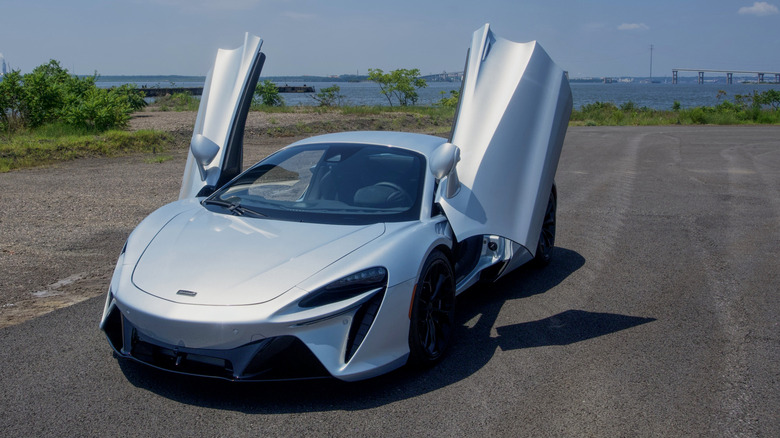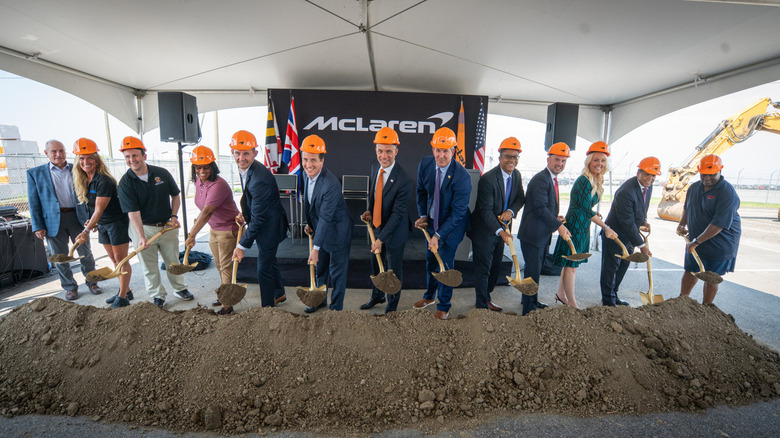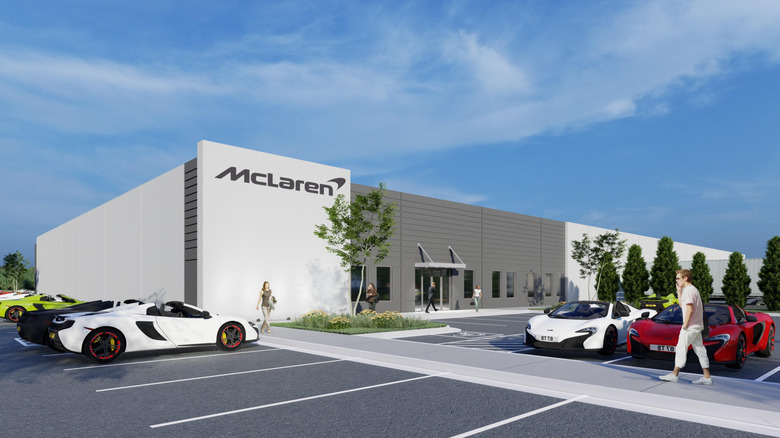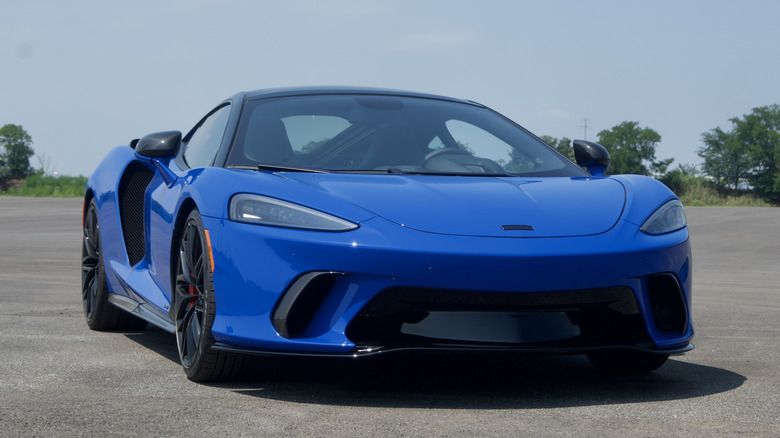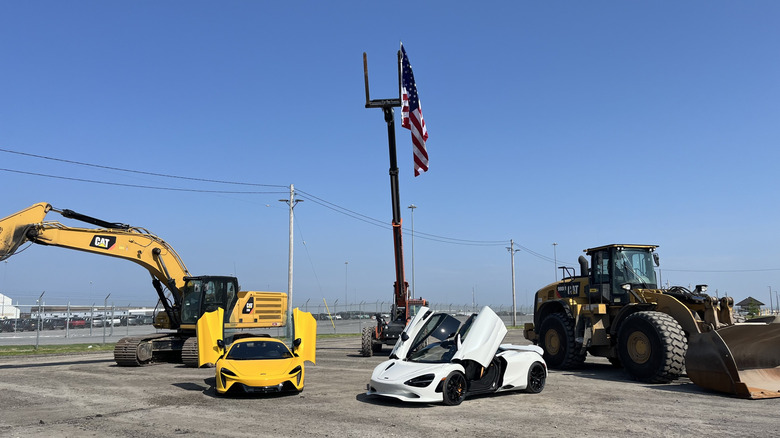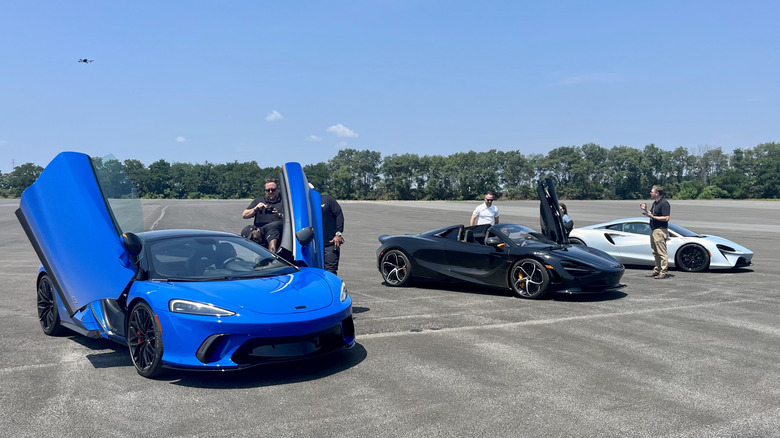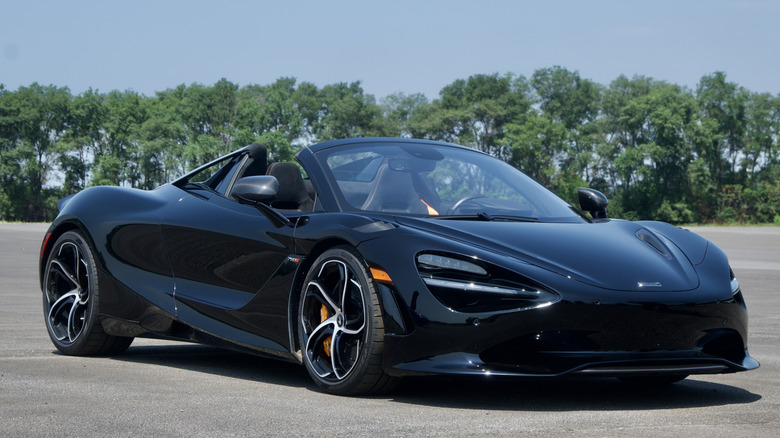McLaren Showed Me How Building A $300,000 Supercar Goes Beyond The Factory Floor
Immediately upon looking at a car like any that McLaren manufactures, you can make a safe guess that at no point will the manufacturing, buying, or driving process will approach anything near normal. That's just par for the course when a car costs over $300,000, is made of more carbon fiber than you thought possible, and has enough horsepower to make aircraft take notice.
To further illustrate the disparity between a McLaren and your average Nissan, McLaren invited me to the groundbreaking ceremony of its future vehicle processing center. It's a facility that will serve as a hub of sorts for every McLaren that gets shipped to the United States which, ironically for a British company, is one of McLaren's biggest markets.
The vehicle processing center and the groundbreaking ceremony wasn't in a swanky location like Los Angeles, Miami, or even New York City, though. It was in my hometown of Baltimore, Maryland, right in the middle of the Port of Baltimore. Coincidentally, the spot for the new facility is very close to where my grandfather worked at Bethlehem Steel after he got back from serving in the Korean War.
McLaren's final check in the assembly line
Familial connection aside, I was more than happy to accept McLaren's invitation. I am a fan of everything Baltimore-related, I consider myself a fan of both McLaren's F1 team and its supercars, and it was a 25 minute drive (including traffic) from my house. It was a no brainer.
The actual ceremony was full of local press, politicians, and McLaren executives talking about what the vehicle processing center will mean for the company, and all a 50,000 square foot facility in the middle of one of America's busiest ports entails. In short, it means a lot.
To quote Nicolas Brown, the President of McLaren, The Americas: "The new McLaren VPC (vehicle processing center) will enable us to fully check and sign off every single car, install local accessory packs, and bring full paint protection film installment directly on site, with the additional bonus of helping to revitalize a brownfield site."
Not a normal production location
When you buy a regular production car, you (for the most part) don't have a lot of say in the production process. Unless you take a lot of time, effort, and cash, to special order something and hope the dealership cooperates, you don't really have a lot of choices aside from what's available at the dealership. Additionally, when a car is made at the factory, it's then shipped by train, truck, or container ship to a place like the Port of Baltimore where it is then distributed to the rest of the country.
That's not really the case with McLaren and it's safe to say that when you buy an Artura, GTS, or 750S, that the production process and subsequent buying process is anything but ordinary The vehicle processing center that McLaren showed me the beginnings of will serve as a hub of sorts for vehicles after they arrive from the main production line in the United Kingdom. Instead of going straight to the dealership, Stateside McLaren techs will take a detailed look at each car, ensuring it safely survived the trip over the Atlantic. Additionally, it will be the place where McLaren installs extra accessories specified by the customer.
Getting crazy with customization
On McLaren's online configurator, the amount of options you get for a car like the Artura is frankly mind-boggling. Obviously, you have a choice of a lot of colors, ranging from the subtle to the flamboyant, but you can also get anything from personalized plaques in the cockpit to a fire extinguisher onboard in case any of your canyon carving sessions result in a potential ecological disaster. A car like a Ford F-150 might have a lot of available options, but it's nothing compared to even McLaren's "entry level" GTS, which still has an MSRP of over $224,000 (and well north of that if you really get enthusiastic with the customization).
With all of those options available to pick from, and the United States serving as a huge market for McLaren, it makes a lot of sense to have a "local" vehicle processing center to make sure everything is just right before the car lands in someone's garage.
Driving McLaren's success
After the ceremony, McLaren convoyed us over to my favorite part: whipping supercars that cost more than a house around an empty parking lot. The other guests and I were greeted with three McLarens, each with their own intended market. There was the McLaren GTS, which is the automaker's more GT-oriented car. Still, it fits the supercar shape of a midengine design and carbon fiber everywhere including a "tub" that's part of every McLaren skeleton. It's powered by a 4.0-liter twin-turbo V8 that gives it 626 horsepower and a top speed of 203 miles per hour.
Next, the McLaren Artura, the company's hybrid model. It's powered by a 3.0-liter V6 that, with help from an electric motor, makes 671 horsepower. It's "just" $225,000 if you have the change laying around. Lastly, there was the 750S, but not "just any" 750S, this was the convertible 750S Spider for good measure. Its 4.0-liter V8 makes 740 horsepower. At its quickest, it has a 0-60 time of 2.7 seconds. It clocks in at $345,000. McLaren's "least" expensive car is over $200,000. And to be fair, you do get a lot for the money. It's worth it for McLaren and its customers that every step of the car's journey is absolutely perfect, and the new vehicle processing center is part of that process.
Why here? Why now?
McLaren isn't a newcomer to the U.S., though, so why now for this processing center, and why Baltimore? It seems reasonable to look not only to recent statements from McLaren that emphasized efficiency and America's place as its largest customer base, but a portfolio set to "be expanded into new product categories" according to an announcement earlier this year. That looks likely to include a McLaren SUV, a strategy we've seen pay clear dividends for rivals like Ferrari and Lamborghini.
New product, and more of it, potentially opens McLaren up to a larger (and more demanding) audience than its current, fairly niche audience of performance car purists. "We need to optimise operations, deliver efficiencies and reshape the new integrated organisation," Nick Collins, McLaren Group Holdings' CEO, said back in April, "so that we can grow our portfolio of cars, enhance customer experience and continue strengthening our global supplier and dealer relationships."
Baltimore is a perfect place to do that. The Port of Baltimore is already the place where thousands upon thousands of cars are moved around every year. It's only logical that McLaren takes advantage of the infrastructure to ensure it can get its cars "from sea to shining sea" as efficiently as possible. If McLaren wants to not only stick it to other supercar brands, but also to prepare for a much higher volume of deliveries, it needs to invest in the markets where it's profitable. Setting roots down in a logistical powerhouse of the United States is a step on that journey.
Good for McLaren, good for customers, good for Baltimore
As for actually driving the cars, sprinting through a large empty lot in my hometown in a midengine supercar with over 700 horsepower is frankly a dream come true. I drove all three McLarens there, but picked the 750S first, because of course I did. The acceleration alone was like being kicked in the head and I tried my best to get it to lose traction even a little bit as I slalomed wildly around. Despite my best efforts, it remained composed. The suspension is tuned and rough. It's a race car through and through and deeply fun to drive. The Artura and the GTS were also explosively fast, yet decidedly more livable than the 750S. If I added multiple zeroes to the end of my paycheck, I wouldn't think twice about buying either.
Maybe fortunately for the car's tires and unfortunately for me, I only spent a few minutes in each car, but not everyone can say that they spent their lunchtime shredding in a McLaren only 25 minutes away from their house, so I'm pretty lucky. I also came away from the trip with a better understanding of not only how McLaren conducts business, but how seriously it takes its products outside of the motorsports sphere. When it opens late next year, McLaren's vehicle processing center will likely not only be a good extra step to ensure McLaren makes a good car, but also a good overall economic boost for Baltimore, a city I love dearly.
